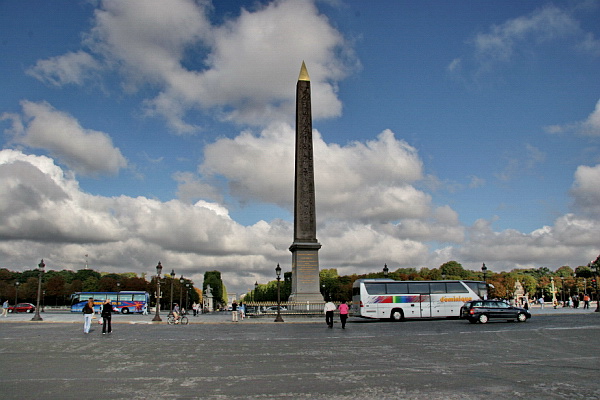Champs Elysees - Place de la Concorde
Place de la Concorde. Obelisque de Luxor.
The Place de la Concorde, which is the largest place in Paris, is situated along the Seine and separates the Tuilerie Gardens from the beginning of the Champs Elysees. It is in the 8th arrondissement, or district, of the city.
Jacques Ange Gabriel, Louis XV's architect, began construction in 1754 and completed it in 1763. It was thus called the Place Louis XV. The place was constructed to hold an equestrian statue of Louis XV that the city of Paris commissioned in 1748 from Bouchardon to offer to the king. The place formed an octagon bordered by large moats that no longer exist. In contrast to older places that were closed, la Place de la Concorde, largely open, served as an intersection as well as a decoration. The equestrian statue marks the intersection of two principal axis: the East-West axis from the perspective of the Tuilerie Gardens and the Champs Elysees, the North-South axis from the perspective of la rue Royale and the bridge created in alignment. With respect to urban accomplishments, it is the greatest achievement of the Enlightenment in the capital.
It became the Place de la Revolution and held in its center the guillotine that executed in particular Louis XVI, Marie-Antoinette, Danton, Robespierre, and 2800 others between 1793 and 1795. It is said that the smell of blood was so strong that a herd of cattle refused to cross the place. After the Revolution it suffered a series of transformations et several changes of name: place de la Concorde, place Louis XV again, place Louis XVI, place de la Chartre, and once again place de la Concorde to symbolize the end of a troubled era and the hope of a better future.

The place today maintains the general appearance that it had in the eighteenth century. The statue of Louis XV, removed during the Revolution, was replaced by the Obelisk of Luxor given by the viceroy of Egypt, Mohamed Ali, to Louis Phillipe. The obelisk, 22.83 meters high and weighing 230 tons, which marked the entrance to the Amon temple at Luxor, was installed in 1836. Hittorf completed the decoration of the place between 1833 and 1846. The obelisk is at the center of an oval whose two centers are fountains constructed at the same period. At each corner of the octagon is found a statue that represents one of the large French cities: Lille, Strasbourg, Lyon, Marseille, Bordeaux, Nantes, Brest and Rouen. The Horses of Marly, monumental statues representing a group of horses, that are found at the beginning of the Champs Elysees are now at the Louvre Museum and have been replaced by copies. The place is bordered to the north by l'Hotel Crillon and l'Hotel of the Navy Minister that frames the rue Royale, to the east by the Jeu de Paume and L'Orangerie of the Tuileries, to the west by the beginning of the Champs Elyses and to the south by the bridge of the Concorde built by Perronnet between 1787 and 1790. This bridge which leads to the Palais Bourbon was enlarged between 1930 and 1932.